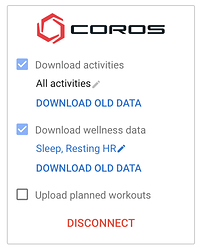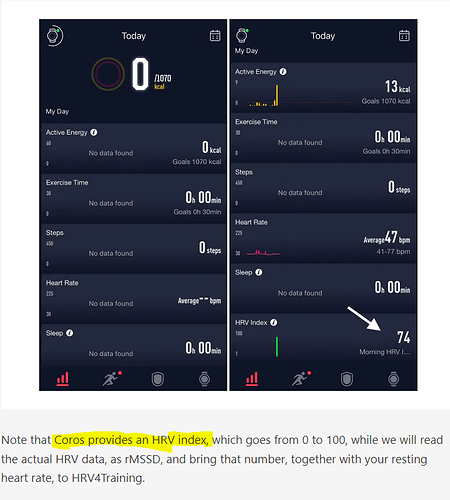Now there’s a stupid decision…
More on that here:
Yea. Think I read that before and that’s also how I knew about them pulling ANT+. Isn’t ANT+ while is a from Garmin, didn’t they like “gift” or still need licensing from them?
Anyways…
dratz… looks like yet another platform that needs you to buy into their hardware before even being able to utilise their platform and/or their API…
Or maybe I just need to apply for API approval and see how that goes…
Tx
I built the Intervals.icu integration without ever having access to Coros hardware.
I use my Coros watch to measure my HRV every morning. This is synced to HRV4Training, which I export to dropbox, which is then read by intervals.icu (rmmsd + rhr).
However, the coros watch measures hr frequently and these measurements override my RHR.
Is it possible to disable this ? Even after manually correcting the RHR, it automatically overrides it again.
@david According to the API doc you can get the HRV values from the api, like hrv4training is doing. Is it possible to add this to intervals.icu?
You need to disable “Resting HR” for Coros wellness download in /settings:
@FrankGNL I will implement the HRV stuff soon.
I have added support for the HRV snapshots. The resting HR value from the snapshot is used instead of the daily resting HR if possible. Click the wellness data list in Coros in /settings to enable HRV.
Awesome thx!! unfortunately the same issues here as in HRV4Training. Looks like 100 is the upper limit. Do you know what values you are getting, are that the HRV index values or rMSSD values?
The docs don’t say the units and I assumed rMSSD. If it is capped to 100 then Coros is doing that. Intervals.icu accepts any value between 1 and 1000 just for some sanity. Sample data from Coros:
rhr=45, hrvList=[timestamp 1688360522 hrv 83.0 hr 50]
rhr=49, hrvList=[timestamp 1688099629 hrv 100.0 hr 56]
Maybe you could contact Coros support?
I’m not familiar with the API, but I know HRV4Training gets the rMSSD from COROS. Not on a 1-100 scale, but the real rMSSD value.
I’m not going to say that rmssd values over 100 are impossible, but it’s rather unusual.
The API docs don’t specify what is being sent as david says.
How do you know for sure that HRV4 gets the rmssd?
From Marco’s substack:
I think that HRV4 applies the inverse formula to get the rmssd. HRV indexes from 0-100 are often a multiple of the natural log of the rmssd. You may want to experiment with the inverse of that or get in contact with Marco. He’s easy to contact over Twitter, but I’m not sure if he’s authorized by Coros to throw the index formula out in the open.
Or maybe he get’s the recorded ECG from the watch and calculates the rmssd in HRV4. In that case, I guess you’re out of luck with Coros HRV ![]()
Link to the source article:
In HRV4Training i have the exact same results as here. 3 days in a row a rMSSD value of 100, off course this is possible but highly unlikely.
Ack thats really annoying. Why not put the real data in the API? Tx for figuring this out.
Aha, in that case you have a perfect opportunity to ask the question at HRV4T, Marco. ![]()
I asked him on Twitter and he said I should ask Coros so I have sent an email. In the mean while I will disable the HRV support since it doesn’t actually work 
The info on this Coros page isn’t very encouraging… Looks like they do plenty of voodoo stuff to get an index for HRV that isn’t representing rmssd anymore.
HRV became a hot topic and every manufacturer wants to make money on it, be it the right or the wrong way…
Edit: added the source page
Coros have responded to my email:
HRV value in API doc represents HRV rMSSD,not the HRV scores (1-100)
I mentioned the lots of 100 values. They have asked for a specific account so they can investigate. @FrankGNL can I send them your info?
Yes you can no problem!
I have re-enabled Coros HRV snapshot support. Coros are going to fix the clipped to 100 bug:
Thanks for the feedback we also find the problem, the score has been limited to 100, We will fix it and release it on Aug.

